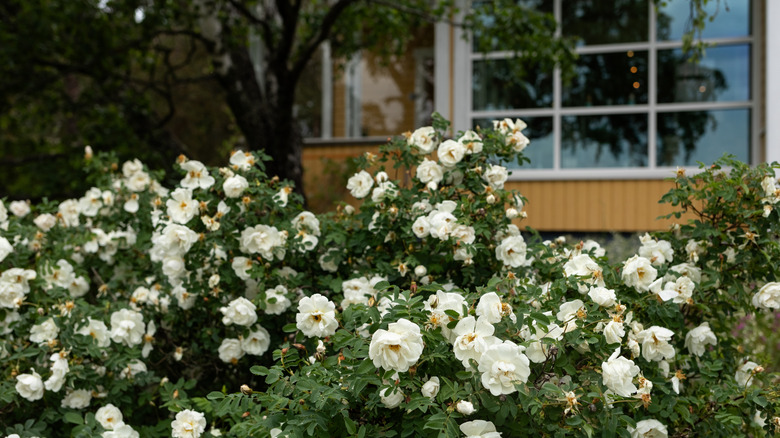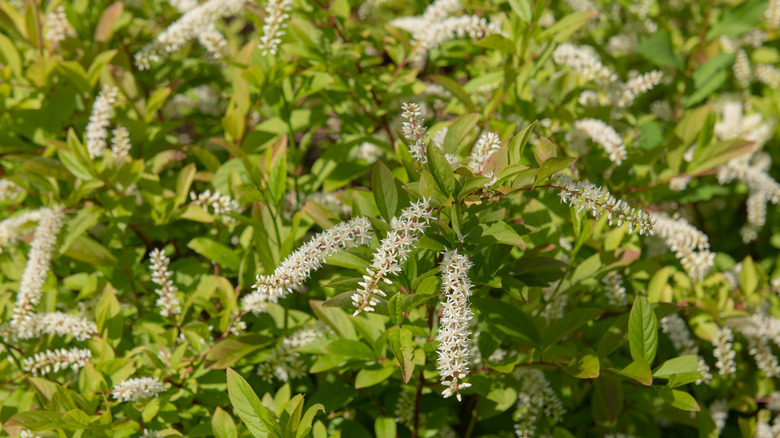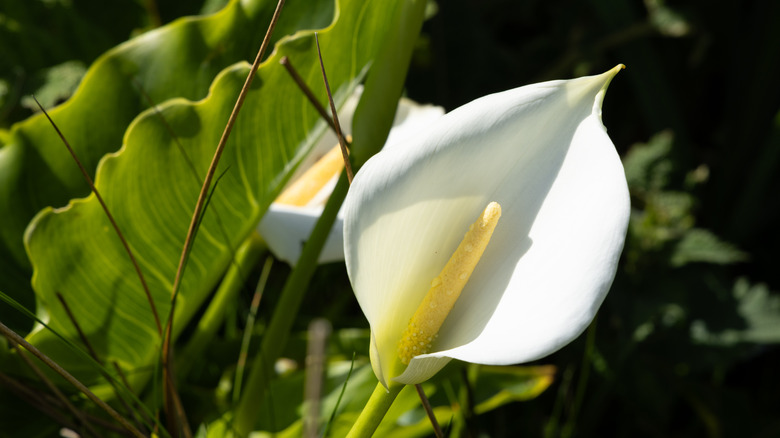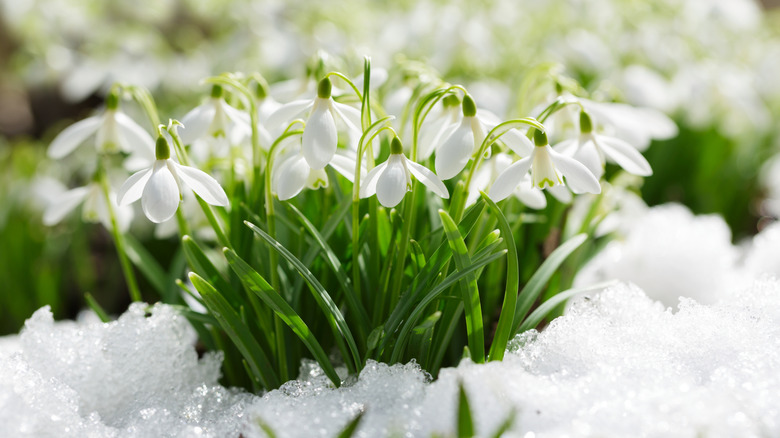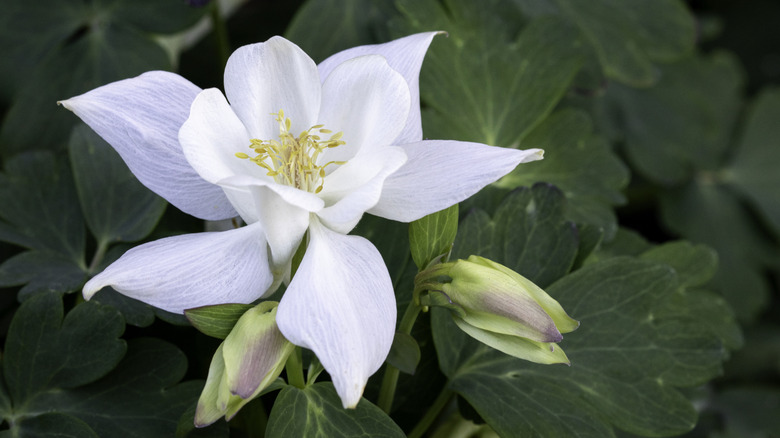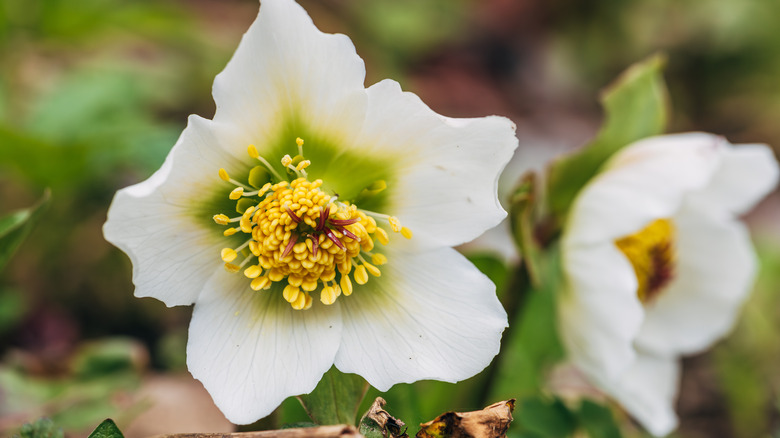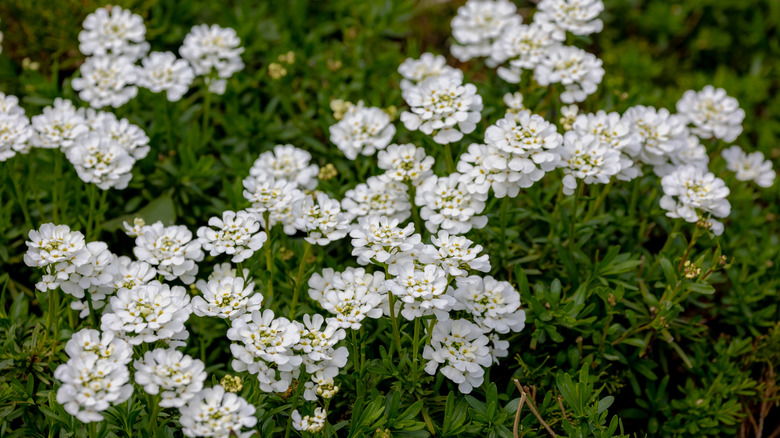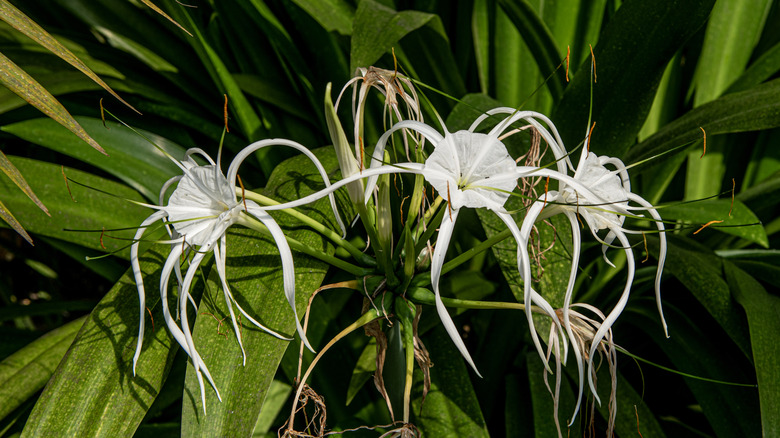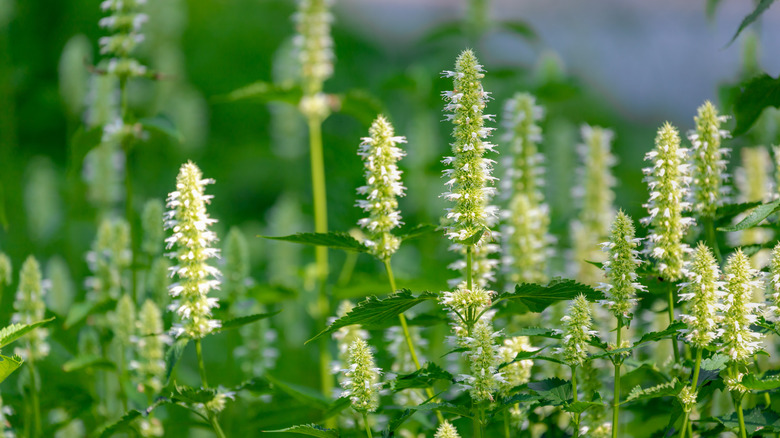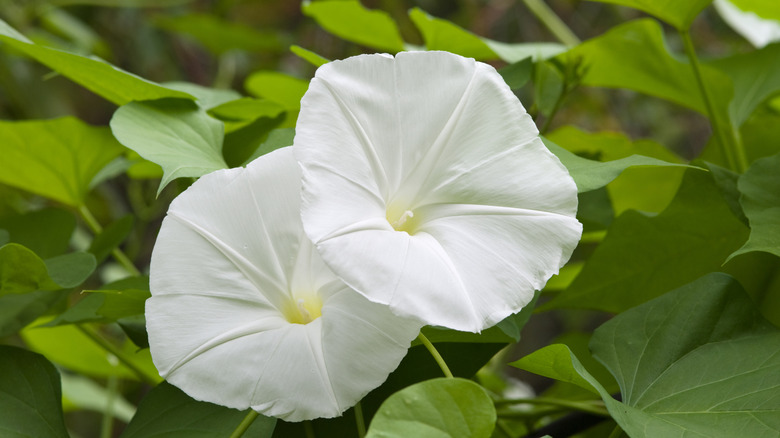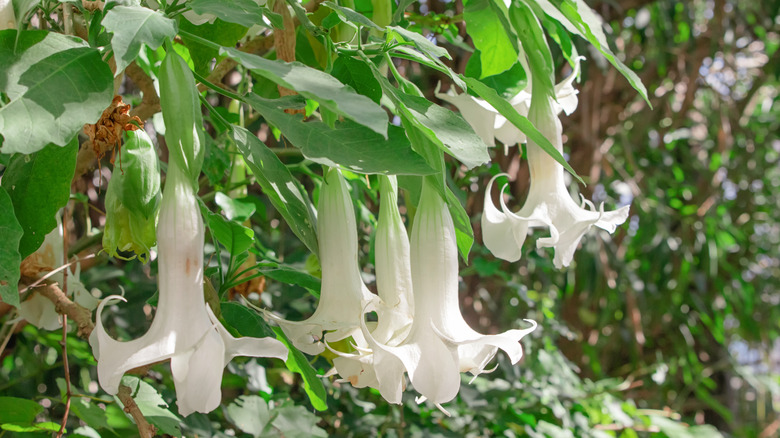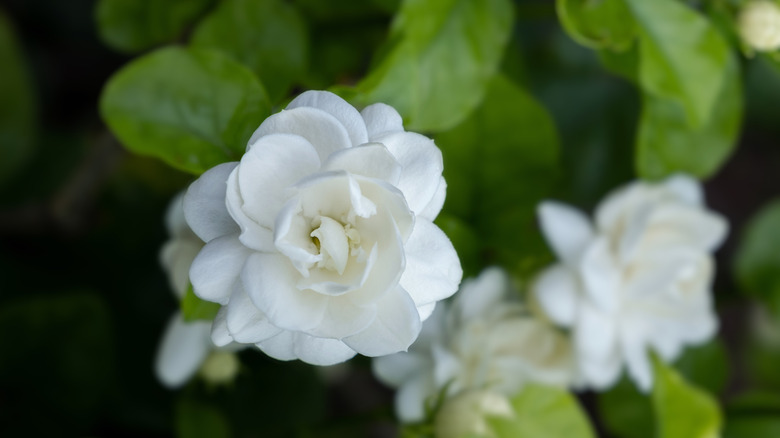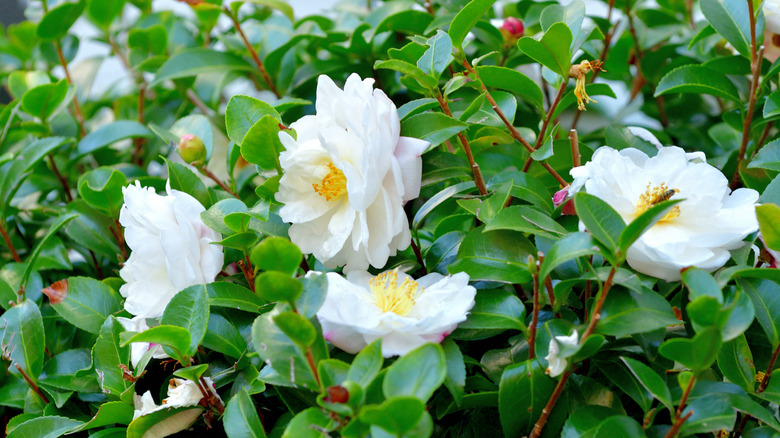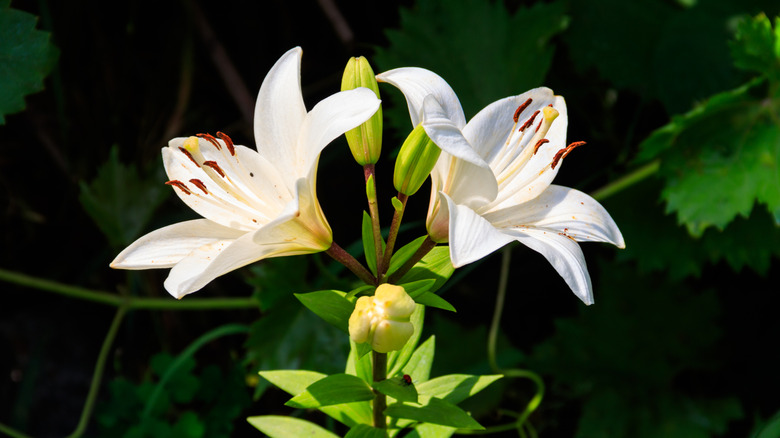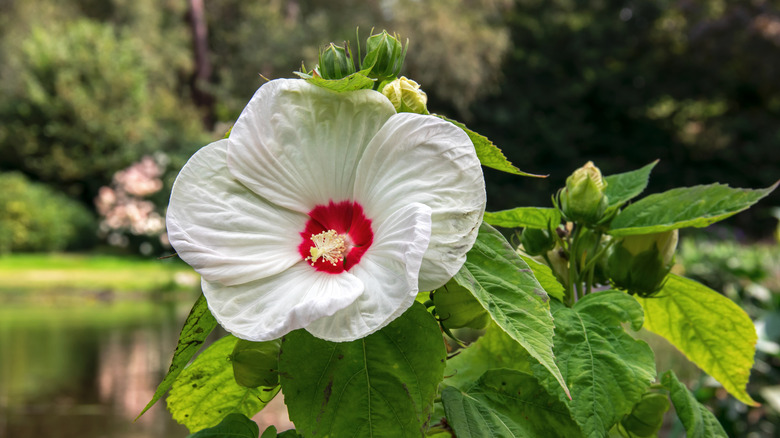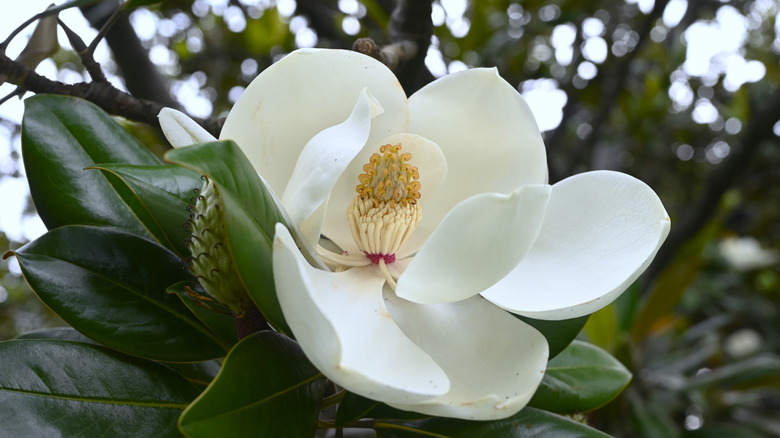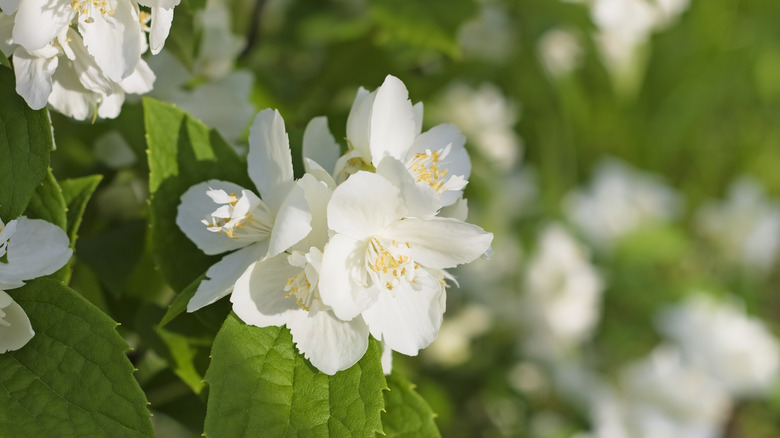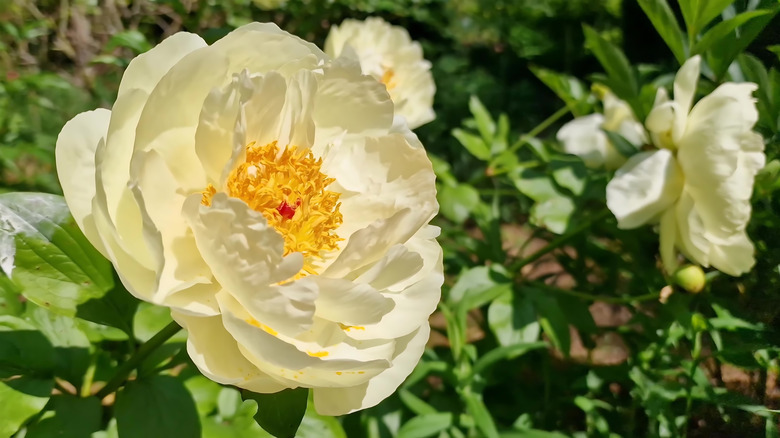17 Best Perennials To Grow For Gorgeous White Flowers
White flowers may seem dull, but their contrast with shades of green creates a calming, peaceful atmosphere in your garden. Who doesn't want to feel relaxed in their outdoor sanctuary? White is one of the most versatile garden flower colors. Not only does stark white make a bold statement, but adding a white flower to your garden will also highlight the vibrant colors of your other plants.
Perennial white flowers come in many different shapes and sizes. From the dramatic blooms of the Chinese peony to the tiny clusters of evergreen candytuft, there's a flower for every style. They can add a tantalizing scent and bring more pollinators into your yard and garden. Adding white perennial flowers to your garden eliminates the need for replanting, ensuring that lush white flowers bloom year after year. With flowers that bloom in all four seasons and thrive in various growing conditions, you're bound to find that one of these flowers will add the finishing touch to your garden.
Virginia sweet spire
Virginia sweet spire (Itea virginica) is a semi-evergreen shrub with long, arching branches bursting with long clusters of delicate white flowers. Come fall, its leaves turn varying shades of red, orange, and gold that last into winter. In its native habitat, Virginia sweet spire is found along swamps and stream banks. It's a great addition to rain gardens and can be planted on slopes to prevent soil erosion. These whimsical flowers are hardy in zones 5 to 9. If you give them the full sun to partial shade and moist soil they crave, you can expect blooms in mid-summer. They grow to about 4 feet tall and wide.
Water arum
From each water arum (Calla palustris) stem grows a single, delicate yet dramatic white spathe. Water arums, a type of calla lily, are native to marshes and bogs and can be grown in wet soil or still, shallow water. These flowers are hardy in zones 2 to 6 and bloom each summer. Water arums thrive in partial shade and moist, humus-rich soil. It's important to note that this plant's foliage is toxic to humans and pets if ingested.
Snowdrop
Snowdrops (Galanthus nivalis) are named for their pure white, teardrop-shaped petals. They are one of the many outdoor plants that thrives in winter weather, blooming from late winter to early spring. They are hardy in zones 3 to 9. They spread easily by themselves, so plant them where they have room to multiply. Snowdrops need full sun to partial shade and well-draining clay or loam soil. They do well as a pop of white under trees or bordering shrubs.
White columbine
The white columbine (Aquilegia coerulea) is a small bush with a big impact. It blossoms with delicate, star-shaped flowers from late spring to early summer. At only 1 to 2 feet tall and wide, it makes a beautiful border plant under trees and shrubs and works well in rock gardens. White columbine is hardy in zones 3 to 9. It requires full to partial shade and tolerates most soil types.
Black hellebore
Black hellebore (Helleborus niger), despite its name, features white, bell-shaped flowers that may fade to pink. Black refers to the color of its roots, which were once used in medicine. Sometimes called Christmas rose, it's another winter-friendly flower that blooms from winter to early spring. Black hellebore is hardy in zones 3 to 8. It requires partial to full shade and rich, moist soil. Black hellebore is a compact plant that can be planted under trees or shrubs or used as ground cover.
Evergreen candytuft
Evergreen candytuft (Iberis sempervirens) is a sprawling ground cover with blooms that attract butterflies from late spring to early summer. Its small flowers grow in dense clusters reminiscent of snowballs. Evergreen candytuft is hardy in zones 3 to 8. These dainty flowers are tolerant of drought, and they should be mulched at the root in winter to prevent damage from frost. Evergreen candytuft thrives in full sun and alkaline to neutral soils.
Spider lily
Spider lily (Hymenocallis) makes a truly unique statement, sprouting flowers with long, spidery tendrils. Native to the southern United States and South America, the spider lily grows in warm marshes and shallow streams. It likes to be wet, so it can be used to border garden ponds and makes a good addition to water gardens. Spider lilies are hardy in zones 10 to 11. This flower flourishes in full sun to partial shade and blooms from late summer to early fall.
White giant hyssop
The white variety of the giant hyssop (Agastache micrantha) blooms from late summer to early fall. Its long stems are clad with tubular tufts of tiny white flowers. Giant hyssops are hardy in zones 6 to 9. This plant requires full sun and well-draining and occasionally dry soil. If you want an edible addition to your garden, giant hyssop's fragrant leaves can be dried and used to make tea. Use these mid-sized bushes in butterfly and rock gardens.
Moonflower
Moonflower (Ipomoea alba), also known as the tropical white morning glory, is famous for its nocturnal flowers whose petals reopen quickly each night. Moonflower is a climbing vine that requires a structure, such as a trellis or fence, to grow on. It blooms with broad, star-shaped flowers from late summer to mid-fall. This hot climate perennial is only hardy in zones 10 to 12 and requires full sun and moist, well-draining soil. Moonflower grows to 10 to 15 feet tall and 3 to 6 feet wide, so it makes a statement on a large area.
Angel trumpet
Angel trumpets (Brugmansia x candida) are a semi-tropical plant that can be grown as a shrub or tree. A true showstopper, its trumpet-shaped flowers can grow to 12 inches long. Angel trumpets typically bloom through spring, summer, and fall, often sporadically throughout the seasons. Angel trumpets can be used in landscaping or kept as a container plant. Angel trumpets are hardy in zones 8 to 10. They love full sun and rich, well-draining soil. They grow up to 10 feet tall and 3 to 5 feet wide
Arabian jasmine
Arabian jasmine (Jasminum sambac)'s fragrant flowers bloom from mid to late summer. Its delicate, rounded petals contrast beautifully against dark green foliage. Arabian jasmine can be grown as a vine on a support or as a compact bush. Native to Southeast Asia, where monsoons are common. Arabian jasmine is hardy in zones 9 to 11. It needs full sun to partial shade and humus-rich, well-draining soil. At 4 to 5 feet tall and wide, Arabian jasmine works well as a border shrub in warm climates.
Sasanqua camellia
Sasanqua camellia (Camellia sasanqua)'s pillowy white flowers boast layers of petals. This Japanese shrub blooms from early fall to winter, a little gift in the barren cold. Sasanqua camellia is a versatile plant that can be used in borders and as accent plants. This plant is hardy in zones 7 to 9. It requires full sun to partial shade and neutral to acidic, well-draining soil. Sasanqua camellia is a large shrub, growing up to 6 to 10 feet tall and wide.
Oriental lily
White varieties of oriental lilies (Lilium 'Casa 'Blanca') are dramatic bell-shaped flowers with contrasting rust-colored stamens. These gorgeous flowers can be grown in the ground or well-draining containers. Oriental lilies are hardy in zones 5 to 8 and bloom in mid-summer. They thrive in full sun to partial shade and organically-rich soil. At their tallest, they will reach about 4 feet tall. It's important to note that oriental lilies, like all true lilies, are toxic to cats.
Rose mallow
Rose mallow (Hibiscus lasiocarpos) is a white flower with a deep crimson center. In the wild, this plant grows in wet soil, so water it often or use it in water gardens. Rose mallow blooms from late summer to early fall. It's hardy in zones 5 to 9 and loves full sun and organically-rich soil. Cutting back the stems to 3 to 4 inches tall in late fall will encourage new growth.
Southern magnolia
Southern magnolias (Magnolia grandiflora), like most magnolia species, have an unmistakable scent that draws you in. At its full height, southern magnolias can provide winter and harsh weather protection for your other plants. While it's quite a large tree, growing up to 30 feet tall in some cases, its creamy blooms and delicious scent are well worth the space it takes up. Southern magnolias are hardy in zones 7 to 9 and bloom in late spring to early summer. Southern magnolias should be planted where they can receive full sun to partial shade in acidic, well-draining soil.
Mock orange
Mock orange (Philadelphus x virginalis) is named for its fresh, citrusy scent. This shrub grows up to 10 feet tall and blooms from late spring to early summer with small groupings of flowers. Mock orange is hardy in zones 4 to 8. It tolerates a wide range of soil types as long as they are well-draining and prefers full sun. Mock orange benefits from regular rejuvenation pruning. Cutting the largest stems from the bottom of the plant encourages new growth.
Chinese peony
The Chinese peony (Paeonia lactiflora), or common garden peony, is loved for its large, pillowy blooms that are packed with petals. Chinese peonies are hardy in zones 3 to 8. With the proper care, you can expect Chinese peonies to bloom from mid to late spring. They should be planted in organically rich soil where they can receive full sun. You should deadhead these flowers after bloom and prune old leaves to ground level in the fall to encourage new growth. Chinese peonies work well as border plants or stand-alone ornamentals.
